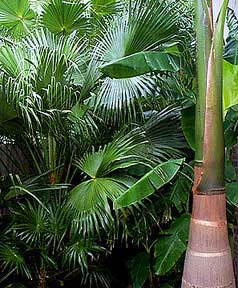If you have a green thumb, a passion for cultivating plants, or an affinity for incorporating fresh herbs into your culinary creations, you might have contemplated the idea of growing your own herb garden. But, for those residing in regions with high humidity, this dream can seem unattainable. Many common herbs such as sage and rosemary favor drier climates akin to the Mediterranean, rendering them poorly suited to humid conditions. However, don’t let this dampen your spirits! A vast array of herbs actually thrives in humid conditions, demonstrating that a lush herb garden is feasible even in the most muggy of environments.
Humidity describes the concentration of water vapor in the air, playing a pivotal role in the health and development of plants. It influences a myriad of plant functions, from photosynthesis rate to vulnerability to certain pests and diseases. While high humidity can present plants with various challenges, such as an increased propensity for disease and hindered water uptake, some plants have adapted remarkably to such conditions, exhibiting high humidity tolerance.
The realm of humidity-tolerant herbs is as diverse as it is intriguing, offering options to complement every flavor profile and culinary tradition. These robust herbs don’t merely survive but genuinely prosper in high humidity, showcasing a hardiness and adaptability that make them a delight to cultivate. With the appropriate understanding and a dash of patience, you can transform a high-humidity environment from a gardening hindrance into a flourishing herbal sanctuary. In the sections to follow, we’ll explore the characteristics that equip these sturdy plants for survival, delve into an assortment of humidity-tolerant herbs worthy of consideration for your garden, and provide advice on how to best grow and utilize them. So, prepare to venture on this humid, yet incredibly rewarding, botanical adventure!
Humidity and Its Impact on Plants
Humidity, or the concentration of water vapor in the air, significantly influences plant development, and herbs are no exception, having their unique optimal growth conditions.
High humidity can complicate a plant’s respiratory process. Tiny openings called stomata on their leaves facilitate this process – they inhale carbon dioxide and exhale oxygen. When the air is overly moist, this vital exchange becomes more challenging, which could inhibit growth and potentially damage the plant.
Yet, humidity isn’t entirely disadvantageous for plants. Many herbs actually prosper in moderately humid environments. It’s more about striking a balance rather than striving for a humidity-free setting. Herbs like basil and lemongrass, which originate from tropical climates, are adapted to high humidity conditions and can find drier climates challenging.
Additionally, high humidity environments can potentially fortify herbs against certain pests and diseases. It also keeps the plants hydrated, minimizing the need for regular watering.
Nonetheless, high humidity does pose some challenges for gardeners. When there’s excess moisture, water may accumulate on the leaves, resulting in fungal infections. Also, some pests, such as slugs and snails, are more prevalent in high humidity settings.
To successfully nurture herbs in high humidity, understanding these advantages and challenges is paramount. Selecting herbs that naturally withstand humidity and adopting practices to alleviate potential humidity-related problems can help you cultivate a thriving herb garden. The next sections will further explore the ideal herbs for humid conditions and how to care for them.
Characteristics of Humidity-Tolerant Herbs
Growing herbs in a high-humidity environment can be quite challenging, as excessive moisture in the air can lead to fungal growth, root rot, and various other plant diseases. However, certain herbs possess unique characteristics that allow them to flourish in these conditions. Understanding these traits can help you cultivate a thriving herb garden even in humid areas.
A. Understanding Humidity Tolerance in Herbs
Humidity tolerance in herbs is essentially their ability to survive and thrive in environments with high moisture levels in the air. This trait is a result of various adaptations that these herbs have undergone over centuries to survive in their native, humid habitats.
For instance, certain humidity-tolerant herbs have developed structures such as trichomes – small, hair-like outgrowths on their leaves. These structures help in heat dissipation and reducing water loss, thereby helping the plant cope with humidity. Basil, for instance, is rich in trichomes, which is one of the reasons it does well in humid climates.
B. Key Traits of Humidity-Tolerant Herbs
Humidity-tolerant herbs often exhibit several common physical and biological traits:
1. Leaf Structure: Many humidity-tolerant herbs have leaves that are designed to reduce transpiration (water loss). Some have thick, waxy leaves that prevent excess water loss, while others have tiny hairs on the leaf surface that trap a layer of air, reducing direct contact with the humid air.
2. Root System: These herbs often have robust root systems that are adept at extracting water and nutrients even from damp soils. They can withstand waterlogged conditions better than many other plant species.
3. Growth Rate: Humidity-tolerant herbs often have a faster growth rate. This quick growth allows them to complete their life cycle before disease or pest problems become severe.
4. Natural Resistance: Many of these herbs have a higher resistance to common humidity-related problems, like mold and mildew. They often produce compounds that suppress or resist the growth of these fungi.
Understanding these traits can help you identify which herbs are more likely to thrive in your humid garden. It can also guide you in providing the best care for these herbs, ensuring that they remain healthy and productive.
Popular Humidity-Tolerant Herbs
Humidity-tolerant herbs are a unique class of plants that thrive in high moisture environments. They not only add a burst of flavor to our meals but also possess medicinal qualities that benefit our health. Let’s delve into some popular humidity-tolerant herbs, their growing conditions, and some practical care tips.
A. Basil
A quintessential ingredient in Italian cuisine, basil thrives in warm and humid environments. It’s an annual herb that comes in various types, from sweet basil to Thai basil, each with a unique flavor profile. Basil prefers well-drained soil and at least six hours of sunlight daily. Watering should be done at the plant’s base to avoid wetting the leaves and encouraging fungal growth.
B. Lemongrass
Common in Asian cuisine, lemongrass, as the name suggests, carries a fresh, lemony aroma. This tropical herb loves the sun and humidity, though it appreciates a little afternoon shade in particularly hot climates. Lemongrass prefers well-draining soil and regular watering to keep its root system moist but not soggy.
C. Mint
Mint, with its invigorating fragrance and flavor, thrives in humid environments. There are numerous mint varieties to explore, including spearmint, peppermint, and chocolate mint. Mint appreciates some afternoon shade in hot climates and well-drained soil that stays consistently moist. Be aware that mint can be invasive, so consider growing it in containers to control its spread.
D. Cilantro
Also known as coriander, cilantro is widely used in Mexican and Asian cuisines. While it prefers cooler weather, some varieties have been bred to withstand higher temperatures and humidity. Cilantro appreciates rich, well-drained soil and regular watering. Harvesting regularly can prevent bolting and prolong the leaf production period.
E. Dill
Dill, a classic ingredient in pickles, is surprisingly humidity-tolerant. This herb enjoys full sun and well-drained, slightly acidic soil. Dill is a bit taller than many other herbs, so ensure it’s protected from strong winds which might cause it to topple over. Dill is a self-seeder, so you may find new plants popping up around your garden each year.
F. Thyme
Thyme, though often associated with cooler climates, can adapt to humid conditions. Varieties like lemon thyme and Caribbean thyme thrive in heat and humidity. Thyme requires well-drained soil and should be watered only when the soil surface becomes dry to avoid root rot.
These are just a handful of the many humidity-tolerant herbs available to the home gardener. Experiment with these and other herbs to discover what grows best in your local conditions.
Nurturing Humidity-Tolerant Herbs
The process of cultivating herbs within high humidity environments can be quite a task, but the rewards make it well worth it. For those who have an interest in nurturing their own humidity-tolerant herbs, here are some pivotal tips and methods to facilitate a fruitful gardening experience.
A. Approaches to Planting and Irrigation
Herbs, like all plants, need a balanced amount of water – avoiding both extremes of overwatering and underwatering. Given that high humidity levels can lead to increased risk of overwatering (as water in the soil evaporates at a slower rate in these conditions), it’s important to carefully space your herbs to promote adequate air flow and circumvent water stagnation. Try to water your herbs during the early hours of the day so that any excess moisture can evaporate under the daytime heat.
B. Suitable Soil and Potting Combinations
Choosing appropriate soil is pivotal for the growth and survival of your herbs. In humid climates, a well-draining soil or potting mix is indispensable to stop excess water from pooling around the roots, leading to root rot. A potting combination that often proves successful consists of compost, coarse sand, and perlite. Compost is a natural provider of essential nutrients, while sand and perlite contribute to enhanced drainage.
C. Considerations for Light and Temperature
Even though humidity-tolerant herbs are typically fond of warmer climates, they can still be impacted by the intensity of sunlight. Most of these herbs lean towards areas with partial sunlight or spots with dappled shade to protect them from excessive heat while still providing necessary light. Monitor temperature as well; many herbs prefer a moderate temperature range, often between 60-70°F (15-21°C).
D. Managing Pests and Disease
Humid environments can often become a breeding ground for various pests and diseases. Typical challenges include fungal afflictions like powdery mildew and pests such as slugs and aphids. Regular inspection of your plants for any signs of disease or pest invasions is key. If you observe any issues, swiftly use suitable organic or non-organic remedies. Encouraging the presence of natural predators like ladybugs and birds in your garden can also prove beneficial in controlling pest populations.
How to Use and Preserve Humidity-Tolerant Herbs in the Kitchen
Ways to Infuse Humidity-Tolerant Herbs into Recipes
Using herbs in your cooking can elevate your dishes by adding an unexpected twist of freshness and unique aromas. For those residing in humid regions, these moisture-loving herbs can be a culinary game-changer. Here’s how you can bring these herbs into a variety of cuisines:
– Basil: This herb, highly celebrated in Italian and Southeast Asian dishes, adds a rich, aromatic layer to pastas, curries, and salads. Think about sprinkling a handful of fresh basil over a home-cooked Margherita pizza or a hot bowl of Pho for an enhanced flavor experience.
– Lemongrass: Known for its distinctive citrus-infused taste, lemongrass plays a central role in Thai and Vietnamese dishes. It works well in marinades for grilled meats, imparts a light, refreshing edge to teas and soups, and even adds an unexpected note to some dessert recipes.
– Mint: Renowned for its energizing flavor, mint can add a fresh twist to a wide range of dishes. It brings a crisp edge to salads, a zesty kick to cocktails, and a vibrant twist to complex sauces like chimichurri or mint chutney. You’ll often find mint in Middle Eastern recipes, including tabbouleh and yogurt-based dips.
– Cilantro: Boasting a unique and recognizable taste, cilantro holds a special place in Latin American and Asian culinary traditions. Its freshness lifts up salsas, curries, and stir-fry dishes. Try cooking up a batch of cilantro-lime rice to enjoy a zesty, colorful side dish.
– Dill: The sweet yet citrusy flavor profile of dill pairs excellently with fish, potatoes, and pickled dishes. It is widely used in Scandinavian and Eastern European recipes, adding a signature touch to gravlax (cured salmon) and borscht (beet soup).
– Thyme: Thyme, with its delicate, earthy taste, is a star in French and Mediterranean cuisines. It enhances poultry, adds a hearty note to stews, and compliments the natural taste of roasted vegetables.
Tips for Preserving These Herbs for Future Use
Although fresh herbs offer the best flavors, their freshness doesn’t last forever. Here are some tried-and-true methods for preserving your humidity-tolerant herbs for future use:
– Drying: This traditional method of preservation involves tying the herb stems and hanging them in a warm, dry area out of direct sunlight. Once they’ve fully dried, they can be stored in airtight containers for future use.
– Freezing: Freezing herbs can help maintain their flavors better than drying. Herbs such as basil, cilantro, and dill can be frozen in olive oil using an ice cube tray. After they’ve fully frozen, they can be transferred to freezer-safe bags.
– Creating Infused Oils or Vinegars: Submerging your herbs in olive oil or vinegar allows the flavors to steep over time. This method not only preserves the herbs but also enhances the oil or vinegar with the herb’s aroma and taste.
The Health Benefits of Humidity-Tolerant Herbs
Not only do humidity-tolerant herbs excel in moist environments, but they are also brimming with impressive health benefits. These herbs are treasure troves of essential nutrients, vitamins, and minerals, which makes them an advantageous addition to a healthy diet. Their medicinal properties have also been appreciated and employed in time-honored healing methods for countless years. Let’s investigate the healthful attributes associated with several well-known humidity-tolerant herbs.
The Nutritional Benefits of Each Herb
1. Basil: This aromatic herb, commonly featured in Mediterranean recipes, is a rich source of vitamin K, crucial for blood clotting processes. It also yields vitamin A, which underpins eye health and immune response, alongside other necessary minerals such as calcium and potassium.
2. Lemongrass: This herb, known for its unique citrus-like flavor and frequent use in Asian cooking, offers a substantial dose of vitamins A and C, acting as potent antioxidants, along with critical minerals like potassium, magnesium, and phosphorus.
3. Mint: Mint, teeming with vitamin A for maintaining eye health, also delivers significant dietary fiber, supporting digestion. Furthermore, it contains an antioxidant called rosmarinic acid, noted for its anti-inflammatory benefits.
4. Cilantro: Cilantro is abundant in vitamins A, C, and K. It’s also a rich supplier of dietary fiber and necessary minerals like potassium, calcium, manganese, and magnesium.
5. Dill: Dill houses a variety of nutrients, inclusive of vitamins A and C, and is notably rich in multiple B vitamins, essential for energy conversion.
6. Thyme: Thyme, a significant provider of vitamin C, is also a reliable source of vitamin A. It’s a robust antioxidant and contains a high concentration of minerals like iron, manganese, and copper.
Healing Properties of These Herbs
Humidity-tolerant herbs, like many other herbs, have been recognized for their healing properties in traditional healing practices around the world.
1. Basil: Beyond its gastronomic appeal, basil possesses anti-inflammatory and antimicrobial traits. It has been used to manage digestive complications and is believed to mitigate stress.
2. Lemongrass: Employed in herbal medicine for its pain-alleviating and anti-inflammatory qualities, lemongrass is also used to lessen anxiety symptoms and displays potential antimicrobial and antifungal properties.
3. Mint: Mint has a long history of use for its digestive advantages. It can alleviate upset stomachs and reduce symptoms of irritable bowel syndrome. Additionally, mint’s aroma is also acknowledged to have soothing effects on the mind.
4. Cilantro: Known for its antioxidant benefits, cilantro has been traditionally used to enhance digestion and as a natural detoxifier, aiding in the removal of toxins from the body.
5. Dill: Dill has been employed for its digestive benefits and to alleviate insomnia. It’s also thought to possess antimicrobial traits.
6. Thyme: Thyme, with its potent antimicrobial attributes, has been traditionally used to handle respiratory issues and alleviate sore throats.
Conclusion
Exploring the world of humidity-tolerant herbs unveils a unique intersection of botany, cuisine, and wellness. These resilient plants not only thrive in humid environments but also offer a myriad of culinary and health benefits. From the aromatic basil to the tangy cilantro, these herbs bring a wealth of flavors to our kitchens. In addition to enhancing our dishes, these herbs also come packed with nutritional benefits, contributing to our overall wellbeing.
Growing humidity-tolerant herbs is a rewarding endeavor. It allows you to tap into the full potential of your humid environment while yielding a fresh supply of herbs right at your fingertips. Whether you’re a seasoned gardener or a novice looking to start a new hobby, cultivating these herbs offers a satisfying experience.
Let this article serve as a guide and a source of inspiration as you embark on your herb gardening journey in a humid climate. There’s a whole world of humidity-tolerant herbs waiting to be discovered and nurtured by you.
Resources for Further Learning
Interested in learning more about humidity-tolerant herbs? Here are some valuable resources to deepen your knowledge and understanding:
Books:
1. The Herbal Kitchen: Cooking with Fragrance and Flavor by Jerry Traunfeld offers a wealth of recipes using various herbs.
2. Rodale’s Illustrated Encyclopedia of Herbs is a comprehensive guide to growing and using herbs.
Online Resources:
1. The Herb Society of America offers a wealth of information about all things herb-related, including a section dedicated to herb cultivation in different climates.
2. The National Gardening Association provides a host of resources, including articles, webinars, and forums, to help gardeners of all levels.
Local and Regional Organizations:
1. Look for local gardening clubs or societies in your area. They often conduct workshops and seminars, providing hands-on learning experiences.
2. Attend farmer’s markets or garden shows in your region. These events often feature a wide variety of plants and provide an opportunity to connect with experienced gardeners.




